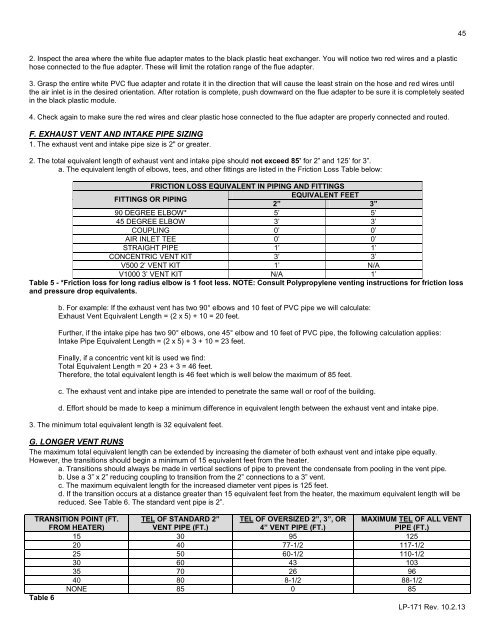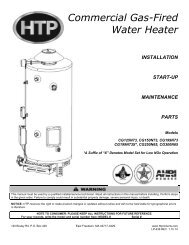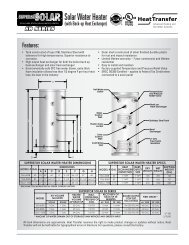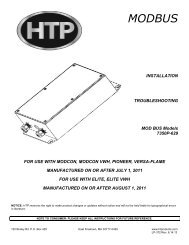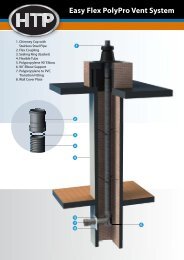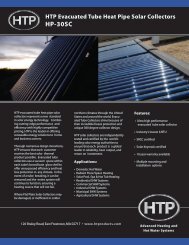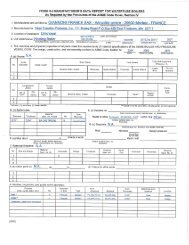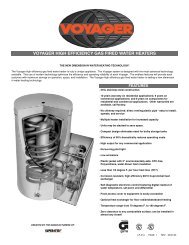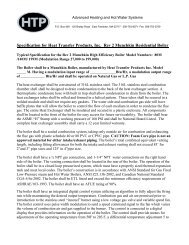MC Series Gas-Fired Circulating Heater - Heat Transfer Products, Inc
MC Series Gas-Fired Circulating Heater - Heat Transfer Products, Inc
MC Series Gas-Fired Circulating Heater - Heat Transfer Products, Inc
Create successful ePaper yourself
Turn your PDF publications into a flip-book with our unique Google optimized e-Paper software.
45<br />
2. Inspect the area where the white flue adapter mates to the black plastic heat exchanger. You will notice two red wires and a plastic<br />
hose connected to the flue adapter. These will limit the rotation range of the flue adapter.<br />
3. Grasp the entire white PVC flue adapter and rotate it in the direction that will cause the least strain on the hose and red wires until<br />
the air inlet is in the desired orientation. After rotation is complete, push downward on the flue adapter to be sure it is completely seated<br />
in the black plastic module.<br />
4. Check again to make sure the red wires and clear plastic hose connected to the flue adapter are properly connected and routed.<br />
F. EXHAUST VENT AND INTAKE PIPE SIZING<br />
1. The exhaust vent and intake pipe size is 2" or greater.<br />
2. The total equivalent length of exhaust vent and intake pipe should not exceed 85’ for 2” and 125’ for 3”.<br />
a. The equivalent length of elbows, tees, and other fittings are listed in the Friction Loss Table below:<br />
FRICTION LOSS EQUIVALENT IN PIPING AND FITTINGS<br />
FITTINGS OR PIPING<br />
EQUIVALENT FEET<br />
2” 3”<br />
90 DEGREE ELBOW* 5’ 5’<br />
45 DEGREE ELBOW 3’ 3’<br />
COUPLING 0’ 0’<br />
AIR INLET TEE 0’ 0’<br />
STRAIGHT PIPE 1’ 1’<br />
CONCENTRIC VENT KIT 3’ 3’<br />
V500 2’ VENT KIT 1’ N/A<br />
V1000 3’ VENT KIT N/A 1’<br />
Table 5 - *Friction loss for long radius elbow is 1 foot less. NOTE: Consult Polypropylene venting instructions for friction loss<br />
and pressure drop equivalents.<br />
b. For example: If the exhaust vent has two 90° elbows and 10 feet of PVC pipe we will calculate:<br />
Exhaust Vent Equivalent Length = (2 x 5) + 10 = 20 feet.<br />
Further, if the intake pipe has two 90° elbows, one 45° elbow and 10 feet of PVC pipe, the following calculation applies:<br />
Intake Pipe Equivalent Length = (2 x 5) + 3 + 10 = 23 feet.<br />
Finally, if a concentric vent kit is used we find:<br />
Total Equivalent Length = 20 + 23 + 3 = 46 feet.<br />
Therefore, the total equivalent length is 46 feet which is well below the maximum of 85 feet.<br />
c. The exhaust vent and intake pipe are intended to penetrate the same wall or roof of the building.<br />
d. Effort should be made to keep a minimum difference in equivalent length between the exhaust vent and intake pipe.<br />
3. The minimum total equivalent length is 32 equivalent feet.<br />
G. LONGER VENT RUNS<br />
The maximum total equivalent length can be extended by increasing the diameter of both exhaust vent and intake pipe equally.<br />
However, the transitions should begin a minimum of 15 equivalent feet from the heater.<br />
a. Transitions should always be made in vertical sections of pipe to prevent the condensate from pooling in the vent pipe.<br />
b. Use a 3” x 2” reducing coupling to transition from the 2” connections to a 3” vent.<br />
c. The maximum equivalent length for the increased diameter vent pipes is 125 feet.<br />
d. If the transition occurs at a distance greater than 15 equivalent feet from the heater, the maximum equivalent length will be<br />
reduced. See Table 6. The standard vent pipe is 2”.<br />
TRANSITION POINT (FT.<br />
FROM HEATER)<br />
Table 6<br />
TEL OF STANDARD 2”<br />
VENT PIPE (FT.)<br />
TEL OF OVERSIZED 2”, 3”, OR<br />
4” VENT PIPE (FT.)<br />
15 30 95 125<br />
20 40 77-1/2 117-1/2<br />
25 50 60-1/2 110-1/2<br />
30 60 43 103<br />
35 70 26 96<br />
40 80 8-1/2 88-1/2<br />
NONE 85 0 85<br />
MAXIMUM TEL OF ALL VENT<br />
PIPE (FT.)<br />
LP-171 Rev. 10.2.13


